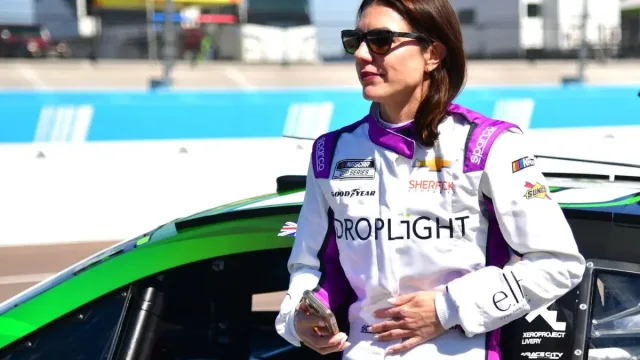Key Highlights
- Katherine Legge’s NASCAR Cup Series debut marks a significant milestone for female representation in NASCAR, despite the challenges she faced during the race.
- The crash that ended Legge’s day raised safety concerns and highlighted the difficulties newcomers encounter in NASCAR, emphasizing the need for better support systems.
- Increased female representation in NASCAR is crucial, underscoring the importance of mentorship and grassroots programs to develop aspiring women drivers.
- Initiatives like the Busch Light Accelerate Her program are essential for promoting female talent and ensuring women have a place in the sport.
- Rising female talents such as Hailie Deegan and Toni Breidinger indicate a potential shift, but consistent industry support is necessary for their success.
A Historic Moment for Katherine Legge
As Katherine Legge approached her NASCAR Cup Series debut at Phoenix Raceway, she stood not only on the starting grid but also on the threshold of history.
At 44, Legge became the initial woman in seven years to compete in a Cup Series race, following Danica Patrick’s final start in 2018. Driving the No. 78 Chevrolet for Live Fast Motorsports, Katherine’s expedition symbolized a meaningful moment for trailblazing women in a traditionally male-dominated sport.
Her presence on the track was a reflection of the racing legacy she aimed to build while overcoming challenges that had plagued her career.
“This is a milestone for women in NASCAR,” she remarked, embodying the spirit of perseverance necessary to inspire future generations and reshape the sport’s narrative.

A Debut to Forget—Early Struggles on Track
Katherine Legge’s much-anticipated NASCAR Cup Series debut quickly turned into a battle against adversity when she spun out just four laps into the race, triggering the initial caution of the day.
Katherine Legge faced immediate challenges in her NASCAR Cup Series debut, spinning out early and igniting the first caution of the race.
Over the team radio, she admitted, “I’m sorry. I’m so tight, and I have so much wheel in it that it got loose on exit.”
Despite this early mistake, Legge exhibited remarkable mental resilience and a resolve to refine her race strategy.
Though the road ahead was fraught with difficulties, Legge’s efforts to push through symbolized the tenacity often required in racing.
The Crash That Ended Katherine Legge’s Day
The struggle for Katherine Legge took a devastating turn when disaster struck with 97 laps remaining in the race. As she was lapped by Josh Berry, Legge lost control in Turn 2, resulting in a disastrous collision with Daniel Suárez’s No. 99 Chevrolet.
The immediate driver reactions were evident; Suárez vented his frustration over the radio, exclaiming, “F— lappers, man. Unbelievable.” This incident not only ended Legge’s day but also raised considerable safety concerns regarding lapped traffic management.
Katherine Legge goes around and collects Daniel Suárez! 👀 #NASCARonFS1 https://t.co/z25cBIBQvE pic.twitter.com/VAYiUx99OL
— FOX: NASCAR (@NASCARONFOX) March 9, 2025
The crash analysis indicated potential lapses in situational awareness that could impact future race implications. As Legge contemplates recovery strategies, the incident highlights the unforgiving nature of the sport and the challenges faced by newcomers in NASCAR.

The Bigger Picture—Women in NASCAR
While the challenges of racing often overshadow the achievements of female drivers, Legge’s debut serves as a crucial reminder of the broader conversation surrounding women in NASCAR.
Her experience emphasizes the urgent need for increased female representation within the sport, in addition to the support networks fundamental for aspiring drivers. Despite the progress made, the landscape of NASCAR remains dominated by men, leaving many potential pathways unexplored.
Legge’s situation exemplifies not just personal struggle but a systemic issue, calling for collective action to create equitable opportunities in racing.
The Future of Women in NASCAR
A new chapter is unfolding in the world of NASCAR, where the future of women in racing hangs in a delicate balance between promise and challenge.
Initiatives such as the Busch Light Accelerate Her program and Susie Wolff’s F1 Academy are crucial in enhancing female representation and creating racing opportunities. Rising talents like Hailie Deegan and Toni Breidinger exemplify the potential waiting to be harnessed.
However, consistent industry support is essential for these athletes to thrive beyond sporadic appearances. Mentorship programs and grassroots initiatives can provide the guidance necessary for aspiring drivers, ensuring they navigate the complexities of the sport.
Katherine Legge’s recent experience serves as a glaring reminder that female competitors must become integral players, not just occasional headlines, in NASCAR’s evolving narrative.

News In Brief: Katherine Legge Inflicts Misfortune on Daniel Suárez
Katherine Legge’s Cup debut, blemished by early struggles and a devastating crash, serves as a clear reminder of the challenges women face in NASCAR. Despite this rocky start, the resilience displayed by Legge and her resolve to push forward highlights a broader movement toward inclusion in motorsports. As conversations about women in racing gain momentum, the hope remains that this setback will pave the way for future successes, inspiring the next generation of female drivers to chase their dreams.
ALSO READ: Katherine Legge Gets Help From NASCAR’s Biggest Names as She Takes on Cup Series Battle
